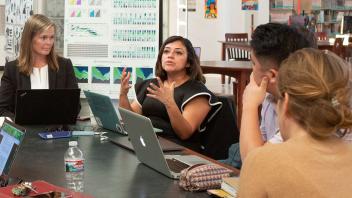I came into the teaching profession aware that my White middle class experience would impact how I taught. I earned my teaching credential and masters degree from a program focused on social justice. There, I’d read and discussed books such as Teaching Other People’s Children and Bad Boys: Public Schools in the Making of Black Masculinity, so I understood, in theory, the blindness and biases I would need to overcome.
In a children’s literature class, we’d gone to publishing houses owned by people of color and I’d learned the importance of stocking my classroom shelves with books that affirmed and expanded upon my students’ experiences. In another class, we analyzed hidden narratives and stereotypes in popular picture books, so I knew that to negate harmful messages I’d need a critical lens.
Because of my training, I entered the classroom armed with good intentions but without much in the way of practical teaching skills. I did what most teachers do — I attempted to learn on the job.
My first school was a high-performing, low-income school, with racial diversity that made every class photo look like a carefully planned casting call. By most definitions, it was a good school with good test scores and I quickly earned a reputation as a good teacher. But even in this seemingly safe and supportive environment, the racist thinking I had been warned about crept in.
It’s not that I didn’t keep reading about culturally responsive pedagogy. And it’s not that I didn’t try to refine my practice. In fact, after reading about White microaggressions and how bias influences the discipline of Black boys, I set up a video recorder in my classroom and invited the parents of my Black boys to help me analyze the footage I collected. But my self-reflection did not result in equitable outcomes for my students. In fact, I now wonder if diving so deep to hunt for racism distracted me from the problems resting on the surface.
Normalizing inequity
A few years into teaching fourth grade, without ever being aware of it, I came to accept the achievement gap as a simple fact of school data. The students in my fourth grade classroom who needed reading intervention were reliably children of color who were poor. Every year, they went down the hall for some extra reading help and I did all I knew how to do in the classroom. I read to my students, matched them with books they loved, facilitated rich class discussions, and I had them write, rewrite, and write some more. All the practice did result in gains, but children who came to my class behind in reading left my class only slightly less behind, I never closed the gap.
I didn’t understand that my students were struggling not because of problems within themselves, but because of the instruction they had (or hadn’t) received. I didn’t know about the assessments that would have identified the root causes of their reading difficulties, and I didn’t have access to research-aligned interventions. The daily experience of seeing students of color struggling while their White and Asian classmates excelled should have set off alarm bells, but it didn’t. Instead, my mind rang with cognitive dissonance — I accepted academic performance that broke along racial lines while believing that I held high expectations for all students.
Explaining away inequity
I was not consciously aware of how classist and racist ideas permeated conversations with my colleagues. Classism was cloaked in seemingly harmless phrases like, “His parents don’t read to him,” “Education is just not that family’s priority,” and “They are from out of the [school] district.” Before long, I fell inline with school staff who accepted that the chairs in the reading intervention room and those outside the principal’s office were nearly always occupied by kids of color.
“Racism is not a fixed category. It’s not what you are, but rather what you are doing and to whom.”
— Ibram X. Kendi
In an interview , Ibram X. Kendi defines racism as “a collection of racist policies that lead to racial inequity that are substantiated by racist beliefs,” and he explains that when faced with evidence of inequitable outcomes, a person can respond to the disparity one of two ways:
- Supporting the data with racist ideas
- Focusing on the racist policies causing inequitable outcomes
My mind flashed to the academic achievement gap.
When confronted with concrete evidence of inequity, educators often justify the status quo. We explain why, due to issues outside of our control, we cannot help students who need more help. We ignore schools that are already doing what we call the “impossible.” We minimize the importance of the data we collect, even though it confirms disparities we see and hear in our classrooms. We discuss poverty and test-bias in our “progressive” circles, but we don’t often make progress.
Fixing inequity
Rather than defend inequality, we need to dismantle the policies causing the achievement gap. We need to ask ourselves difficult questions:
1. When we disaggregate our data, what do we see and what do we say?
- What reasons do we provide for our data? Are our narratives free from racist and classist assumptions?
2. What instruction do students receive inside and outside of school hours?
- Do families with means supplement our instruction in a way that perpetuates the achievement gap? If so, what can we do to improve the instruction to which all children have access?
3. What do we expect of our students’ families? Does every child have someone who is reliably able to meet those expectations or do our policies privilege some students over others?
- What are our policies for homework, school supplies, science fairs and other projects?
- How are children expected to develop background knowledge, vocabulary, skills in the arts and sciences?
- How do we handle the varied pace at which students master foundational reading skills? Do all students receive sufficient practice and support?
- How do our students navigate their educational choices? Does every child have enough guidance?
4. What resources and privileges must families have in order to participate in our school community?
- Must they be able to leave work during the day? Travel by car? Read and/or write in English?
- Are there caregivers we never see? How can we change that?
5. How do our behavior policies impact the instruction to which children have access?
- Is education approached as a right? Or as a privilege, that can be withheld from students?/li>
- Are some students kept from important school experiences? Which students? Why?
6. Are we collecting predictive data so we know which students are likely to encounter difficulty in reading? Or are we waiting for children to struggle?
7. Have we sufficiently prioritized and planned early intervention?
- Are we using evidence-based, targeted interventions to address the root cause(s)? Or are we tracking students in leveled groups?
8. How are we holding ourselves accountable to the community? Do families know the trends in our data and our plans to improve achievement?
A recent article in the Washington Post seemed to speak directly to me:
“The right acknowledgment of black justice, humanity, freedom and happiness won’t be found in your book clubs, protest signs, chalk talks or organizational statements. It will be found in your earnest willingness to dismantle systems that stand in our way — be they at your job, in your social network, your neighborhood associations, your family or your home. It’s not just about amplifying our voices, it’s about investing in them and in our businesses, education, political representation, power, housing and art.”
I, like so many others, was spurred into deep self-reflection by current events, but I know that good intentions and anti-racist theory can’t inoculate me against the racism that riddles our educational system. Facing and fixing the policies that create and perpetuate the achievement gap is the work of an anti-racist educator. It’s not enough to mean well, we need to do good.
About the Author
Margaret Goldberg is the co-founder of the Right to Read Project, a group of teachers, researchers, and activists committed to the pursuit of equity through literacy. Margaret serves as a literacy coach in a large urban district in California and was formerly a classroom teacher and curriculum developer. All posts are reprinted with permission from the Right to Read Project .

